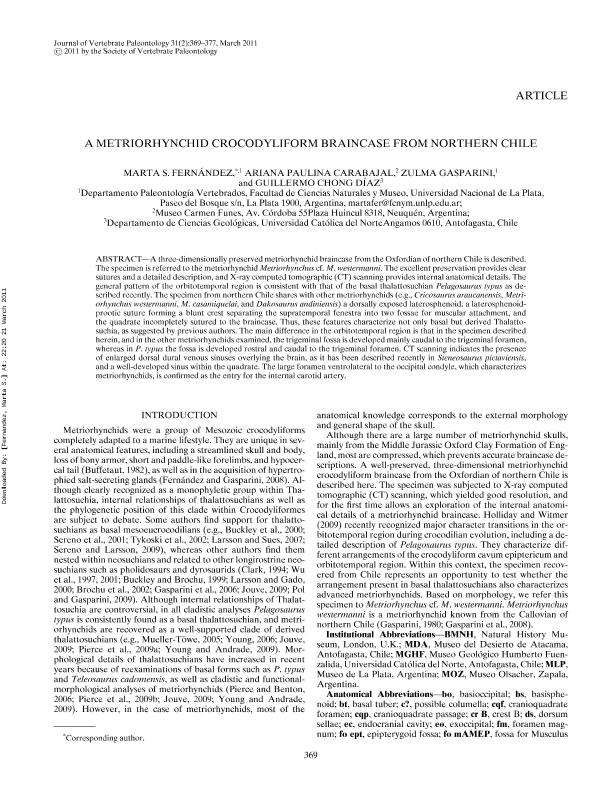Mostrar el registro sencillo del ítem
dc.contributor.author
Fernández, Marta Susana

dc.contributor.author
Paulina Carabajal, Ariana

dc.contributor.author
Brandoni, Zulma Nelida

dc.contributor.author
Chong Díaz, Guillermo
dc.date.available
2020-05-13T18:41:03Z
dc.date.issued
2011-03-21
dc.identifier.citation
Fernández, Marta Susana; Paulina Carabajal, Ariana; Brandoni, Zulma Nelida; Chong Díaz, Guillermo; A metriorhynchid crocodyliform braincase from northern Chile; Society of Vertebrate Paleontology; Journal of Vertebrate Paleontology; 31; 2; 21-3-2011; 369-377
dc.identifier.issn
0272-4634
dc.identifier.uri
http://hdl.handle.net/11336/105053
dc.description.abstract
A three-dimensionally preserved metriorhynchid braincase from the Oxfordian of northern Chile is described. The specimen is referred to the metriorhynchid Metriorhynchus cf.M. westermanni. The excellent preservation provides clear sutures and a detailed description, and X-ray computed tomographic (CT) scanning provides internal anatomical details. The general pattern of the orbitotemporal region is consistent with that of the basal thalattosuchian Pelagosaurus typus as described recently. The specimen from northern Chile shares with other metriorhynchids (e.g., Cricosaurus araucanensis, Metriorhynchus westermanni, M. casamiquelai, and Dakosaurus andiniensis) a dorsally exposed laterosphenoid, a laterosphenoidprootic suture forming a blunt crest separating the supratemporal fenestra into two fossae for muscular attachment, and the quadrate incompletely sutured to the braincase. Thus, these features characterize not only basal but derived Thalattosuchia, as suggested by previous authors. The main difference in the orbitotemporal region is that in the specimen described herein, and in the other metriorhynchids examined, the trigeminal fossa is developed mainly caudal to the trigeminal foramen, whereas in P. typus the fossa is developed rostral and caudal to the trigeminal foramen. CT scanning indicates the presence of enlarged dorsal dural venous sinuses overlying the brain, as it has been described recently in Steneosaurus pictaviensis, and a well-developed sinus within the quadrate. The large foramen ventrolateral to the occipital condyle, which characterizes metriorhynchids, is confirmed as the entry for the internal carotid artery.Metriorhynchus cf.M. westermanni. The excellent preservation provides clear sutures and a detailed description, and X-ray computed tomographic (CT) scanning provides internal anatomical details. The general pattern of the orbitotemporal region is consistent with that of the basal thalattosuchian Pelagosaurus typus as described recently. The specimen from northern Chile shares with other metriorhynchids (e.g., Cricosaurus araucanensis, Metriorhynchus westermanni, M. casamiquelai, and Dakosaurus andiniensis) a dorsally exposed laterosphenoid, a laterosphenoidprootic suture forming a blunt crest separating the supratemporal fenestra into two fossae for muscular attachment, and the quadrate incompletely sutured to the braincase. Thus, these features characterize not only basal but derived Thalattosuchia, as suggested by previous authors. The main difference in the orbitotemporal region is that in the specimen described herein, and in the other metriorhynchids examined, the trigeminal fossa is developed mainly caudal to the trigeminal foramen, whereas in P. typus the fossa is developed rostral and caudal to the trigeminal foramen. CT scanning indicates the presence of enlarged dorsal dural venous sinuses overlying the brain, as it has been described recently in Steneosaurus pictaviensis, and a well-developed sinus within the quadrate. The large foramen ventrolateral to the occipital condyle, which characterizes metriorhynchids, is confirmed as the entry for the internal carotid artery.
dc.format
application/pdf
dc.language.iso
eng
dc.publisher
Society of Vertebrate Paleontology

dc.rights
info:eu-repo/semantics/openAccess
dc.rights.uri
https://creativecommons.org/licenses/by-nc-sa/2.5/ar/
dc.subject
CROCODYLIFORM
dc.subject
METRIORHYNCHID
dc.subject
BRAINCASE
dc.subject
CHILE
dc.subject.classification
Paleontología

dc.subject.classification
Ciencias de la Tierra y relacionadas con el Medio Ambiente

dc.subject.classification
CIENCIAS NATURALES Y EXACTAS

dc.title
A metriorhynchid crocodyliform braincase from northern Chile
dc.type
info:eu-repo/semantics/article
dc.type
info:ar-repo/semantics/artículo
dc.type
info:eu-repo/semantics/publishedVersion
dc.date.updated
2020-05-04T19:53:41Z
dc.journal.volume
31
dc.journal.number
2
dc.journal.pagination
369-377
dc.journal.pais
Estados Unidos

dc.journal.ciudad
Lawrence
dc.description.fil
Fil: Fernández, Marta Susana. Universidad Nacional de La Plata. Facultad de Ciencias Naturales y Museo. Departamento Científico de Paleontología de Vertebrados; Argentina. Consejo Nacional de Investigaciones Científicas y Técnicas. Centro Científico Tecnológico Conicet - La Plata; Argentina
dc.description.fil
Fil: Paulina Carabajal, Ariana. Consejo Nacional de Investigaciones Científicas y Técnicas. Centro Científico Tecnológico Conicet - La Plata; Argentina. Provincia del Neuquén. Municipalidad de Plaza Huincul. Museo "Carmen Funes"; Argentina
dc.description.fil
Fil: Brandoni, Zulma Nelida. Consejo Nacional de Investigaciones Científicas y Técnicas. Centro Científico Tecnológico Conicet - La Plata; Argentina. Universidad Nacional de La Plata. Facultad de Ciencias Naturales y Museo. Departamento Científico de Paleontología de Vertebrados; Argentina
dc.description.fil
Fil: Chong Díaz, Guillermo. Universidad Católica del Norte; Chile
dc.journal.title
Journal of Vertebrate Paleontology

dc.relation.alternativeid
info:eu-repo/semantics/altIdentifier/url/https://www.tandfonline.com/doi/full/10.1080/02724634.2011.550361
dc.relation.alternativeid
info:eu-repo/semantics/altIdentifier/doi/http://dx.doi.org/10.1080/02724634.2011.550361
Archivos asociados
